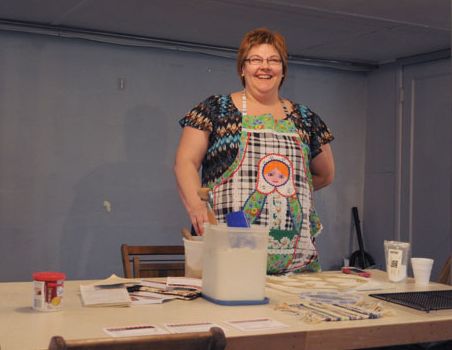The Gift of South Dakota
Subscriptions to South Dakota Magazine make great gifts!
Subscribe today — 1 year (6 issues) is just $29!
Christmas Cookies With a Twist
 |
| Deb Mehrer demonstrated her family's ammonia cookie tradition at a gathering of the Germans from Russia Society in Kaylor. |
Don’t eat the cookie dough if Deb Mehrer of Scotland is running the mixer. It’s not due to any health scare, like salmonella from raw eggs or E. coli in the flour. What you want to watch out for is her secret ingredient. Before it’s baked, dough made with baker’s ammonia, also known as hartshorn or ammonium carbonate, is guaranteed to leave a bad taste in your mouth.
Ammonia may seem like a rather toxic cookie addition, but the unusual ingredient has been used in Germany and Scandinavia for centuries. Once made from deer antlers, ammonium carbonate acted as a leavener in the days before baking powder and baking soda. The white powder, which is a close relative to the smelling salts used to revive fainting ladies, has a nostril-piercing aroma that bakes off in the oven, creating cookies that can be thin and crispy or soft, thick and cakey, but leaving no unpleasant cleaning fluid aftertaste.
Ammonia cookies are a beloved tradition in Mehrer’s family — one that she recreated last June for a meeting of the SoDak Stamm chapter of the Germans from Russia Heritage Society in Kaylor. The aroma generated by the baking cookies was very familiar to the livestock farmers in the audience. “When you get that smell in the chicken barn you clean it out,” joked Eugene Weidenbach of Lesterville, as he watched Mehrer prepare her dough. Another audience member recommended moving pet birds out of the house before baking a batch, as the ammonia fumes might kill them.
But the end result is much more appetizing than that first hot blast of ammonia gas escaping from the open oven door might indicate. Not overly sweet, the thick, pale, frosting-coated cookies are so soft that they won’t hold up to a good coffee dunking. “It’s almost a little cakelike,” Mehrer says.
A nurse at the Scotland Medical Clinic, her love of her culinary heritage started young — she’s been baking since she was 10 years old. Though her mother, Betty Faller, gave Mehrer a handwritten cookbook containing the recipe for ammonia cookies, she had to experiment a little in order to recreate that childhood taste. “It was missing some key instructions, like how much flour, at what temperature and how long you bake them. I remembered the taste of them, so I had to try it out for myself,” Mehrer says.
Mehrer’s family celebrates their Germans from Russia heritage at their annual holiday feast, which they dubbed German Fest. The menu is a mouthwatering assortment of German-Russian dishes. Kuchen, sausage from the Blue Bird Locker in Delmont and German potato salad are always served. “My sister-in-law is 100 percent Dutch and makes the hot potato salad — not bad for a Dutch girl,” Mehrer says. Butterscotch pan dumplings are another favorite, prepared in a cast iron pan by her 83-year-old aunt, Rosemary Laib of Armour. Fleisch kuechle, deep-fried pockets of dough-covered meat, knoephfla soup, cheese buttons and spaetzle have also made appearances on the German Fest table. German flags, Oktoberfest napkins and German beer add to the festive atmosphere.
“We wanted to celebrate the foods my mom used to make for us growing up,” Mehrer says. “The first bite takes you back to your childhood.”
 |
Ammonia Cookies
Recipe by Betty Faller
1 teaspoon baker’s ammonia
1 cup milk
2 cups sugar
1 cup shortening or lard
4 eggs
1 teaspoon vanilla
3+ cups of flour — enough to
stiffen the dough
Soak baking ammonia in milk for 10-15 minutes. Cream shortening or lard and sugar together. Mix in milk, eggs and vanilla. Add three cups of flour, then add more flour, 1/2 cup at a time, until the dough stiffens but is still somewhat sticky. Use your hands if you have to. Place dough in the refrigerator to rest — at least overnight, but four or five days is even better.
Preheat oven to 360 degrees. On a floured surface, roll dough out to between 1/4 and 1/2 inch thick and cut with a flour-dipped cookie cutter, glass or a tin can without the lid. Place on an ungreased cookie sheet and bake about 6 to 8 minutes, until lightly browned on bottom but still pale on top.
Let cookies rest on the cookie sheet for 3-5 minutes, then remove to a baking rack. When cool, frost with white frosting and decorate with sprinkles, if desired. These cookies are better if you wait a couple of days before eating. Store in a sealable plastic container or freeze. Makes approximately six dozen.
Note: Baker’s ammonia probably can’t be found in your local grocery store’s baking section. Check with your local pharmacy, a specialty food store or order online. Because baker’s ammonia evaporates with prolonged exposure to air, store it in a tightly sealed container.
Editor’s Note: This story is revised from the November/December 2016 issue of South Dakota Magazine. To order a copy or to subscribe, call (800) 456-5117.










Comments